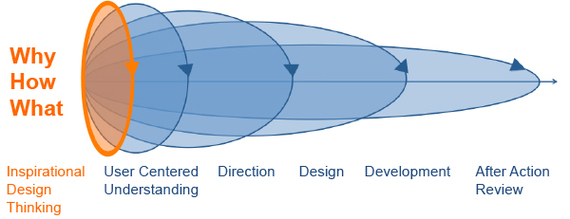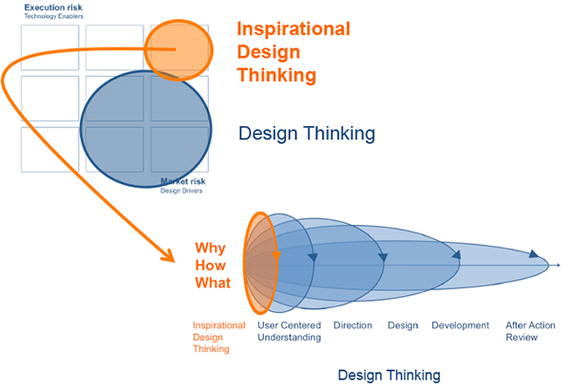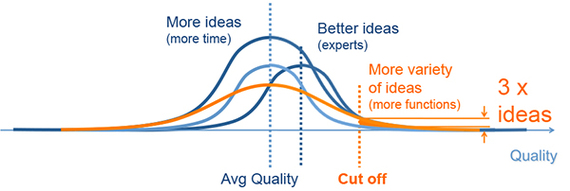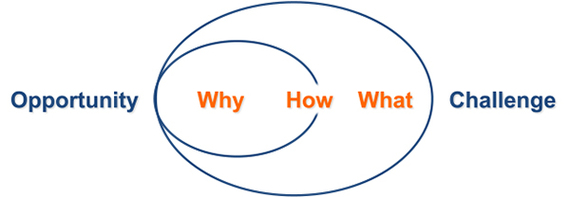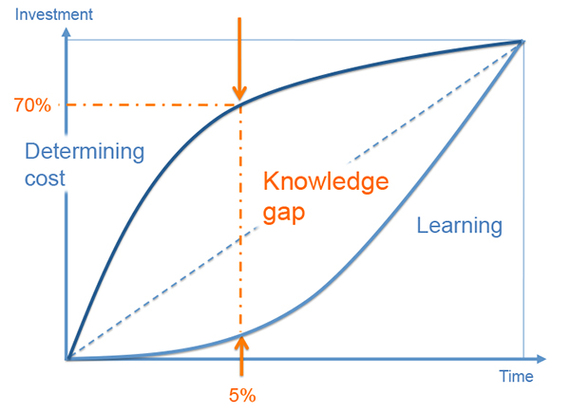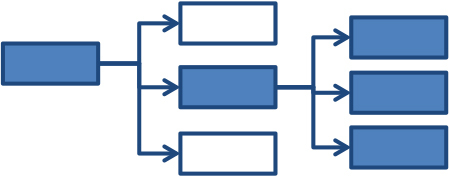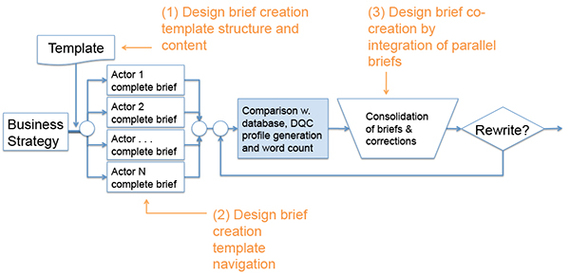A society's progress depends upon the quality of the questions it asks itself and to know what questions to ask today in order to secure a sustainable future.
One question could be: "Why design something at all?" Our society obsesses over entrepreneurship, innovation and design for creating growth, however few stop and ask 'Why,' or, think about the high impact "Why's - What's - How's" before doing any Design Thinking at all. For a society, organization or individual to make meaningful progress, this balance will be required for long and short-term investments in the development process.
With its focus on user needs, Design Thinking is excellent at developing incremental offerings; however, for breakthrough innovation users cannot provide the answer or even pose the question. Henry Ford said: "If I had asked the customer what they wanted, they would have asked for a faster horse."
It must be remembered that when the automobile was first seen by the public it was viewed as a menace to society. More recently, even experts predicted the iPad would fail like all the previous pads in the marketplace. Only Innovators and Early Adopters initially see the value in a new and embryonic offering and when users are initially presented with a true breakthrough innovative offering, most detest it. Even the more successful entrepreneurs get it wrong, like when Ken Olsen (founder of Digital Equipment Corporation (DEC) said in 1977, "there's no reason for any individual to have a computer in his home".
Creating breakthrough innovation takes inspiration, as well as, Design Thinking. We have to encourage innovation by making it so ordinary that it becomes a part of our core business. A small group of design science researchers have proposed developing a repeatable approach to creating breakthrough innovation by merging the two worlds of inspiration and Design Thinking into Inspirational Design Thinking.
This approach would focus on identifying big questions - then using these questions to inspire exploration of the high-impact, high-market risk and high-technology risk opportunities. Setting this initial direction would ensure that the development team is working on beautiful ideas for breakthrough innovation. This process involves what Simon Sinek calls "Inside out thinking", beginning with the raison d'être and using that as the innovative propellant which will then result in 'creative thrust' to break through the inertia that results from 'outside in thinking' (starting with what and how).
We must be prepared to invest in dreams and aspirations, and end up with a philosophy in which Design Thinking is not a job, it's a way of life. Design thinkers seldom differentiate between life and work. It is only when we successfully align all those involved in the innovation process to exemplify their work in this manner, that true innovation can take place.
To determine the key elements necessary to make 'Inspirational Design Thinking' work, researchers consulted experts in areas such as marketing, investment, behavioral economics, New Product Development and engineering. The top seven elements are identified below.
1) Creative leadership, ecosystem and spaces
What environment and leadership style is conducive for experts to generate these BIG Questions?
Studies of teams at Stanford University, Yonsei Business School and by ingomar&ingomar - consulting suggest that multiple teams working in isolation from each other generate a far wider variety of ideas.
When it comes to leading these teams - they may benefit from being lead in the same way as were the top tier creative professionals at BMW GROUP - as little as possible and very much like Venture Capitalists lead entrepreneurs. This increases the variation of outcomes and thus increases the number of useful business and design concepts
2) Breakthrough Innovation Process
Inspirational Design Thinking will benefit from focusing on identifying unusual high-impact BIG open-ended questions, such as "Does our current form of Capitalism still serve us best?" Exploring this direction can lead to the more focused question: Are people willing to monetize their home environment and allow strangers to sleep there? Or, are people willing to drive strangers around town in their personal car for profit? Although these answers might appear obvious today, they were considered ludicrous only a few years ago.
These types of ideology questions residing with groups on the edges of society may be uncovered using Big Data Analytics and then be synthesized by ingenious individuals. This cannot happen, however, without assistance from a large diverse social network, because creating breakthrough ideas requires lots of ideas, high quality ideas and many different types of ideas.
3) Leading key stakeholders
Decision-makers capable of killing an idea before it has been proven need to be onboard from the beginning and be kept up-to-date. These stakeholders can also provide valuable input on how to move the idea into a valid design.
4) Market creation
Arthur Schopenhauer said that: "All truth passes through three stages. First, it is ridiculed. Second, it is violently opposed. Third, it is accepted as being self-evident." The adoption of breakthrough innovation follows much the same path. Therefore, an Inspirational Design Thinking approach will need to evangelize and leverage emerging new ideologies. Innovators will also need to be persuaded to use Design Driven Innovation to curate new ideas for Early Adopters to place in context. Then, conventional Design Thinking with user-centered design will finally move into market research for identifying the Early Majority customer segments.
5) Incorporated learning and building of dynamic capabilities
A steep learning curve is inherent in the development of breakthrough innovations, which makes the management of learning and building of dynamic capabilities essential. What competitive advantages need to be built in-house and what can safely be brought in from outside?
6) Decision-support focused on reducing risk
When developing breakthrough innovation, one cannot rely on developing scenarios and assigning probabilities. The only way forward is to reduce ambiguity and then mitigate risk by identifying the elements with the highest risk and work on reducing these risks. Developing a decision-pattern map can provide an overview over current and potential future decisions and work on risk reduction.
7) Providing input into an Inspirational Design Brief
When a brilliant breakthrough innovation opportunity has finally been identified, it needs to be communicated to the design team so they can apply conventional Design Thinking to develop it from an idea to a sustainable offering. Here, the Inspirational Deign Briefing method has proven useful. It combines crowdsourcing input with multiple iterations, optimizing the brief according to nine key Design Quality Criteria. The final brief reduces ambiguity and increases exploration, as well as, performance.
This is our initial proposal for identifying the key elements necessary for an Inspirational Design Thinking method that can produce breakthrough innovations. Over the spring and summer our design science research team will further develop the framework and test it on innovation projects around the world using Applied Design Science's Design Valuation Dashboard. Please share your thoughts and ideas with us as we continue to share our emerging insights with you, so, together, we can create progress and not just growth.
Special thanks to Gasper Patrico, Chris Bangle, Ade Mabogunje, Tore Kristensen, Jaewoo Joo, Finn Birger Lie, John Fitch, Gjoko Muratovski, Barry Katz, Mark Breitenberg, Johan Vardrup and John von Buelow for researching and offering input to this article
